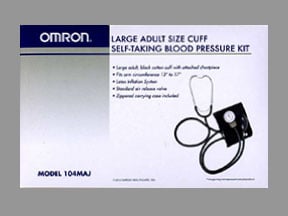
Self-taking Blood Pressure Coupons & Savings Card – Discount Prices from $20.17
My prescription
Edit
1, Self-taking Blood Pressure (1 Kit)
Select pharmacy

Walgreens
$20.17
COUPON PRICESelf-taking Blood Pressure savings card
Show this card to your pharmacist
Walgreens
$20.17
BIN
ID
PCN
GRP
019876
LH16637F6C
CHIPPO
LHX
Powered by
Self-taking Blood Pressure dosage forms
Dosage Quantity Price from Per unit 1nan 1 Kit $20.17 $20.17
| Dosage | Quantity | Price from | Per unit |
|---|---|---|---|
| 1nan | 1 Kit | $20.17 | $20.17 |
Self-taking Blood Pressure Warnings
Monitoring your blood pressure at home can be a valuable tool in managing hypertension, but it's important to be aware of potential risks to ensure accurate readings and effective treatment. One significant concern is the accuracy of home blood pressure monitors. Studies have found that a substantial number of these devices may provide incorrect readings. For instance, research indicated that up to 15% of home monitors used by patients gave inaccurate measurements, with 30% deviating by more than 5 units in systolic readings and 32% in diastolic readings. Such discrepancies can critically impact treatment decisions, underscoring the importance of verifying your device's accuracy against standard equipment used in medical offices.
Another risk involves the proper use of the blood pressure monitor. Incorrect cuff placement, improper positioning, and user error can all affect the accuracy of home blood pressure readings. Inaccurate readings can lead to misdiagnosis or the false assurance that one’s blood pressure is under control when it may not be. To mitigate this, it's essential to follow the manufacturer's instructions carefully and consult with your healthcare provider to ensure you're using the device correctly.
Additionally, the type of monitor you use matters. While wrist and finger monitors are available, they are generally not recommended due to less reliable readings. The American Heart Association advises using an automatic, cuff-style, upper-arm monitor for the most accurate measurements. Ensuring the cuff fits properly is also crucial, as an ill-fitting cuff can lead to inaccurate readings.
It's also important to recognize that home monitoring should complement, not replace, regular check-ups with your healthcare provider. Self-monitoring can provide valuable information, but it doesn't capture the full picture of your cardiovascular health. Regular professional evaluations are necessary to assess your overall condition and adjust treatment plans as needed.
By being aware of these risks and taking appropriate precautions, you can effectively use home blood pressure monitoring as part of your overall health management strategy.
Self-taking Blood Pressure Side Effects
Monitoring your blood pressure at home is a valuable tool for managing hypertension, but it's important to be aware of potential challenges that can affect the accuracy of your readings. One common issue is the use of wrist blood pressure monitors. While they may seem convenient, wrist monitors are often less reliable than upper arm devices. This is because wrist measurements can be influenced by the position of your arm and wrist, leading to inaccurate readings. For the most dependable results, it's recommended to use a monitor with a cuff that fits around your upper arm. Another factor that can impact accuracy is the size of the cuff. Using a cuff that's too small or too large for your arm can lead to incorrect readings. It's essential to select a cuff that fits your arm properly to ensure accurate measurements. Proper technique is also crucial when measuring your blood pressure. Common mistakes include placing the cuff over clothing, not supporting your back or arm, crossing your legs, or talking during the measurement. These errors can cause your readings to be higher or lower than they actually are. To obtain accurate results, sit comfortably with your back supported, feet flat on the floor, and your arm at heart level. Ensure the cuff is placed directly on your bare skin, and remain still and silent during the measurement. It's also important to be aware of the "white coat effect," where blood pressure readings are higher in a medical setting due to anxiety. Conversely, some individuals may experience "masked hypertension," where their blood pressure is normal in a doctor's office but elevated at home. Regular home monitoring can help identify these patterns, providing a more comprehensive picture of your blood pressure. By understanding and addressing these potential challenges, you can ensure that your home blood pressure monitoring provides accurate and useful information for managing your health.
Self-taking Blood Pressure Interactions
When measuring your blood pressure at home, it's important to be aware of factors that can influence your readings. Certain activities and conditions can cause temporary increases in blood pressure, leading to inaccurate measurements.
Physical Activity: Engaging in exercise or even basic household tasks just before measuring can elevate your blood pressure. To ensure accuracy, rest quietly for at least five minutes before taking a reading.
Stress and Anxiety: Emotional states like stress or anxiety can temporarily raise blood pressure. This is sometimes referred to as the "white coat effect," where the presence of a healthcare professional causes an increase in readings. To minimize this, create a calm environment during measurements and avoid discussing stressful topics.
Caffeine and Smoking: Consuming caffeine or smoking within 30 minutes prior to measuring can lead to higher readings. It's best to avoid these substances before taking your blood pressure.
Full Bladder: A full bladder can add up to 10 to 15 mmHg to your blood pressure reading. Ensure you use the restroom before measuring.
Improper Positioning: Sitting with crossed legs, unsupported back, or an unsupported arm can affect readings. Sit upright in a chair with your feet flat on the floor, back supported, and arm resting at heart level.
Incorrect Cuff Placement: Using a cuff that's too tight, too loose, or placed over clothing can lead to inaccurate readings. Ensure the cuff is snug but not too tight and placed directly on the skin.
By being mindful of these factors and following proper measurement techniques, you can obtain more accurate blood pressure readings at home.
